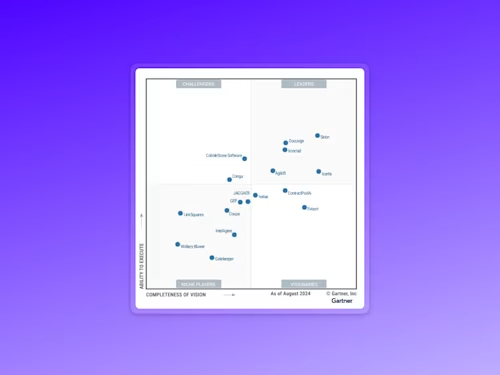
Does Your Business Need Enterprise Contract Management Software?
Here's a quick guide to help you determine whether your business will benefit from an enterprise CLM solution. Average ROI is 356%.


Enterprise contract lifecycle management (CLM) solutions streamline end-to-end contract management and can save the average business as much as 9% of its annual revenue. For many companies, those savings translate to hundreds of thousands of dollars a year.
Still, some businesses are on the fence about investing in CLM software—committing themselves to inefficient manual or paper-based contract management procedures. If this sounds like your organization, here's a quick guide to help you determine whether your business will benefit from an investment in an enterprise CLM solution.
What Is Contract Lifecycle Management?
Before you can determine whether enterprise contract lifecycle management (CLM) software will make a marked difference for your company, it’s important to know what a CLM does.
As documents make their way through your organization, administrative tasks and complex manual workflows create bottlenecks in the contract management process, limiting your capacity for growth and putting an unnecessary strain on key buyer/vendor relationships. Contract lifecycle management increases productivity, eliminates risks, and drives revenue at every step of the contract management process by introducing:
Centralized, searchable repositories
Flexible, configurable workflows
Templated document generation
Workflow automation
Clause libraries
Digital audit trails and 360-degree visibility
Increased security
After enhancing existing procedures with an integrated CLM solution, businesses see an average ROI of 356%—by minimizing exposure to risks, reducing human error and significantly accelerating time to contract completion.
The impact that contract management has on your organization can vary based on factors like your organization’s size, the complexity of existing workflows or the industry in which your business operates.
Now that you know what contract management can do, it’s time to evaluate: is CLM right for your business?
Start by asking the right questions
Contract management isn’t often associated with profitability—yet many businesses spend a significant percentage of their resources on contracts. From authoring and reviewing to negotiating and signing, a single contract can cost your business as much as $49,000.
Not only could your current contract management process be wasting resources, you may be exposing your organization to unnecessary risks and putting a needless strain on key client relationships.
The following five questions will help you gauge whether a contract management solution is right for your business.
How complex is your current contract management process?
From authoring and negotiating to reviewing and approving—every contract your organization produces passes through a familiar carousel of people and departments (sales, legal, financial, etc.). Even the most basic documents, like NDAs, may see approval and revisions from three, five or even 10 parties—and that’s before it gets seen by a client or vendor.
The more complex your document management process is, the more likely you are to benefit from a CLM solution that lets you orchestrate intelligent document workflows and automate manual tasks.
Complexity is an indelible part of growth. As your organization prepares for the future, a contract management solution offers seamless scalability—equipping you with the tools you need to expand your operation.
What metrics are you using to evaluate your current procedures?
What does a complex contract management process look like? Before you can truly assess your organization’s contract management needs, it’s essential to identify the biggest pain points in your current process. If you don’t have data on key metrics, like those outlined below, you’re probably not managing your contracts efficiently.
What is the cycle time of an average contract?
How many actors are typically involved with each contract?
How long does your team spend negotiating contracts?
How long does it take you to retrieve a contract from storage?
How do you evaluate compliance or security risks in contract language?
An understanding of your current process will point you toward the right solutions. For instance, as the number of actors involved in the creation or negotiation of a single contract starts to climb, so does the opportunity for human error to creep into existing workflows. In a survey of over 1,300 contracting professionals, 90% of respondents said that human error has a significant impact on their contracting process—resulting in:
Delays in closed deals (37%)
Increased costs (34%)
Missed opportunities due to misunderstood contracts (31%)
Increased noncompliance risk (29%).
There is no magic number of actors or a single metric that will tell you when it’s time to upgrade to enterprise contract management software, but a better understanding of your organization’s existing procedures is a great place to start.
What level of compliance does your organization need?
In highly regulated industries that call for strict compliance like healthcare and finance, document generation and end-to-end document management has an added layer of complexity—which can create costly delays in the contracting process.
The greater your compliance needs, the more a contract management solution can de-escalate risk.
With regulatory landscapes constantly evolving, new contracts require strict adherence to those regulations; but your organization may also need to filter through pre-existing contracts to identify and rework outdated language. For example, as the London Interbank Offering Rate (LIBOR) is phased out of existence, $240 trillion worth of contracts may need renegotiating. Without the right system in place to quickly analyze and mitigate risks, the price of managing your contracts will only continue to grow.
Do you have an intelligent, searchable contract repository?
How long does it take you to locate an existing document using your current contract management solution_?_
The number one contract management challenge that organizations face is finding and analyzing existing documents. Currently, only 23% of business professionals say they can find a contract in 10 minutes or less—an already astoundingly low number. But it’s also a significant drop from last year’s 32%, according to an annual Docusign survey.
Document management is only growing in complexity. An agile infrastructure is critical for businesses that wish to keep up with the dizzying pace at which today’s digital work environment is evolving. Despite rapid change, many businesses still use paper file cabinets to organize their contracts—and 39% of today’s documents are stored as unsearchable PDFs. Neither of these methods offer the quick access or search functionality to support efficient contract management.
AI integrated CLM software provides searchable repositories, clause libraries, and automated risk assessment tools to help organizations find the right document in seconds—significantly reducing the expense, time, and risk of contract generation and end-to-end management.
How do you manage contract tracking and visibility?
Sixty-nine percent of businesses use email to route their contracts between departments. On the surface, this sounds okay. But the reality is: once a contract leaves your hands, it becomes invisible.
What do you do if a client asks for a status update? How do you track down a document that hasn’t resurfaced? Using email as your contract tracking mechanism is like building walls between legal, sales and procurement teams.
A 360-degree view of the contract lifecycle is critical. In addition to giving disparate teams the visibility and open communication they need to track contracts from start to finish, an automated CLM solution provides a digital audit trail that maintains document security, helps reduce risks, and makes it easy to hold all parties accountable for their role in the contracting process.
Contract visibility can help you speed up contract time to completion, identify critical workflow complications and manage client expectations.
What can CLM do for your business?
The benefits of an enterprise contract management solution are easy to see. A recent survey of 1,333 participating organizations showed that, after implementing a CLM solution, the average business saw a 50% reduction in contract completion time and an 80% reduction in contract drafting time. Procurement, sales and legal teams benefitted the most from CLM.
The benefits of CLM are clear. Increase agility between departments with searchable contract repositories, workflow automation and intelligent document handling . These are the competitive advantages of modern contract management and the ticket to increased profitability for your organization.
Related posts
Docusign IAM is the agreement platform your business needs



